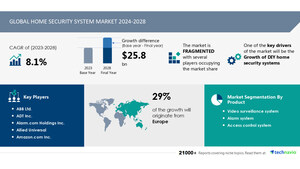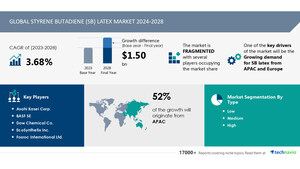NEW YORK, March 25, 2024 /PRNewswire/ -- The global healthcare landscape is witnessing a transformative shift with the advent of advanced medical technologies. Among these innovations, blood viscometers stand out as indispensable tools in the diagnosis and management of vascular diseases. A recent market analysis forecasts remarkable growth in the blood viscometer market between 2023 and 2027, with an anticipated increase of USD 13,049.76 thousand, marking a steady Compound Annual Growth Rate (CAGR) of 7.22%.
Here is an Exclusive report talking about Market scenarios with a historical period (2017-2021) and forecast period (2023-2027). Download Sample Report in minutes!
The escalating prevalence of vascular diseases coupled with the burgeoning healthcare expenditure fuels the demand for blood viscometers, which play a pivotal role in assessing the fluid dynamics of blood flow. These instruments offer valuable insights into the viscosity of blood, aiding in the identification of potential vascular disorders and facilitating timely interventions.
Key Market Drivers and Trends
The rise in vascular diseases acts as a significant driver propelling market growth, highlighting the critical role blood viscometers play in assessing cardiovascular health. Moreover, technological advancements drive innovation, with companies investing in Research and Development (R&D) to develop cutting-edge viscometers. For instance, Benson Viscometers and Cambridge Viscosity are pioneering the development of innovative products, enhancing user-friendliness and integration into healthcare settings.
Challenges and Opportunities
Despite the promising trajectory, challenges such as the high cost of blood viscometers pose barriers to market expansion, particularly in price-sensitive regions. However, the emergence of point-of-care diagnostics offers new avenues for growth, with portable and cost-effective devices reshaping the market landscape.
Here is an Exclusive report talking about Market scenarios with a historical period (2017-2021) and forecast period (2023-2027). Download Sample Report in minutes!
Regional Insights
North America emerges as a frontrunner in market contribution, with the US and Canada leading the charge. Major players like BioFluid Technology Inc. and RheoSense Inc. are driving innovation in the region, offering advanced products based on cutting-edge technologies. Meanwhile, regions like Europe and Asia-Pacific exhibit significant growth potential, fueled by increasing healthcare expenditure and a growing awareness of cardiovascular health.
Segment Analysis
The market is segmented based on product type and end-users, with rotational viscometers and capillary viscometers catering to diverse healthcare needs. Hospitals and diagnostic centers emerge as key end-users, leveraging blood viscometers for comprehensive cardiovascular assessments.
Here is an Exclusive report talking about Market scenarios with a historical period (2017-2021) and forecast period (2023-2027). Download Sample Report in minutes!
Market Players and Strategies
Leading companies like Anton Paar GmbH, Benson Viscometers Ltd., and Cambridge Viscosity Inc. are implementing strategic initiatives to enhance their market presence. These include strategic alliances, partnerships, mergers, and acquisitions, fostering innovation and expanding geographical reach.
Analyst Review
As the prevalence of cardiovascular diseases continues to escalate, the demand for blood viscometers is poised to surge. While challenges such as cost constraints persist, the market is ripe with opportunities for innovation and strategic partnerships. With a focus on user-friendly and cost-effective solutions, the blood viscometer market is set to revolutionize cardiovascular care, offering efficient and accessible diagnostics for improved patient outcomes.
The Blood Viscometer Market is witnessing a surge in demand, fueled by advancements in technology and a growing prevalence of cardiovascular diseases worldwide. Blood viscosity measurement devices have become essential tools in diagnosing and managing these conditions effectively. However, the market is facing challenges such as expensive viscometers and budget constraints, which hinder widespread adoption.
To address these challenges, manufacturers are developing advanced models with cutting-edge technology. These viscometers offer quick results, making them suitable for point-of-care testing. Moreover, the trend towards portable and user-friendly devices is gaining momentum, enhancing device utilization and overcoming the lack of awareness among healthcare professionals.
Research and development efforts are focusing on creating cost-effective devices without compromising accuracy and reliability. The market potential for these devices is substantial, driven by the rising demand for point-of-care diagnostics. However, strategic positioning is crucial in navigating the competitive landscape.
Analyzing the market dynamics using Porter's Five Forces framework reveals investment possibilities for stakeholders. The threat of new entrants is relatively low due to the high capital requirements and regulatory barriers. Additionally, the bargaining power of suppliers is moderate, given the availability of multiple suppliers of key components.
The bargaining power of buyers is high due to the presence of numerous options and the emphasis on cost-effective solutions. Intense competition among existing players further intensifies this power. Nonetheless, strategic partnerships and innovative product offerings can mitigate this threat.
The prevalence of cardiovascular diseases continues to rise globally, driving the demand for blood viscometers. Point-of-care diagnostics are becoming increasingly important in managing these conditions effectively. Cost-effective devices that deliver accurate results are expected to gain traction in the market, catering to the needs of both healthcare professionals and patients.
In conclusion, the Blood Viscometer Market presents significant opportunities for investment, driven by the increasing demand for advanced and cost-effective devices. Strategic positioning, innovation, and awareness-building efforts are vital for success in this competitive landscape. With the right approach, stakeholders can capitalize on the market's potential and contribute to improving healthcare outcomes for patients with cardiovascular diseases.
Here is an Exclusive report talking about Market scenarios with a historical period (2017-2021) and forecast period (2023-2027). Download Sample Report in minutes!
Market Overview
In conclusion, the Blood Viscometer Market presents a promising landscape characterized by innovation, strategic partnerships, and a growing emphasis on point-of-care diagnostics. With advancements in technology and a burgeoning demand for cardiovascular health solutions, the market is poised for remarkable growth in the coming years.
The Blood Viscometer Market is witnessing remarkable advancements in technology, offering cutting-edge solutions for measuring blood viscosity. While expensive viscometers with advanced models dominate the market, there's a growing need to address budget constraints and lack of awareness. Innovative devices, including portable and user-friendly options, are gaining traction for point-of-care testing. These portable devices facilitate convenient and efficient measurement of blood viscosity, enhancing device utilization across various healthcare settings. With the emphasis on accessibility and ease of use, manufacturers are focusing on developing advanced models equipped with state-of-the-art technology. As the market evolves, the integration of advanced features in blood viscometers continues to drive improvements in patient care and clinical outcomes.
Here is an Exclusive report talking about Market scenarios with a historical period (2017-2021) and forecast period (2023-2027). Download Sample Report in minutes!
Related Reports:
Blood Glucose Monitoring Devices Market - The blood glucose monitoring devices market size is estimated to grow at a CAGR of 8.88% between 2022 and 2027. The market size is forecast to increase by USD 7,488.81 million.
Intravenous (IV) Solutions Market- The intravenous IV solutions market size is estimated to grow at a CAGR of 7.11% between 2022 and 2027. The market size is forecast to increase by USD 4,011.34 million.
Key Topics Covered:
1 Executive Summary
2 Landscape
3 Sizing
4 Historic Size
5 Five Forces Analysis
6 Segmentations
7 Customer Landscape
8 Geographic Landscape
9 Drivers, Challenges, and Trends
10 Vendor Landscape
11 Vendor Analysis
12 Appendix
About US
Technavio is a leading global technology research and advisory company. Their research and analysis focuses on emerging market trends and provides actionable insights to help businesses identify market opportunities and develop effective strategies to optimize their market positions. With over 500 specialized analysts, Technavio's report library consists of more than 17,000 reports and counting, covering 800 technologies, spanning across 50 countries. Their client base consists of enterprises of all sizes, including more than 100 Fortune 500 companies. This growing client base relies on Technavio's comprehensive coverage, extensive research, and actionable market insights to identify opportunities in existing and potential markets and assess their competitive positions within changing market scenarios.
Contact
Technavio Research
Jesse Maida
Media & Marketing Executive
US: +1 844 364 1100
UK: +44 203 893 3200
Email: [email protected]
Website: www.technavio.com/
SOURCE Technavio

WANT YOUR COMPANY'S NEWS FEATURED ON PRNEWSWIRE.COM?
Newsrooms &
Influencers
Digital Media
Outlets
Journalists
Opted In





Share this article